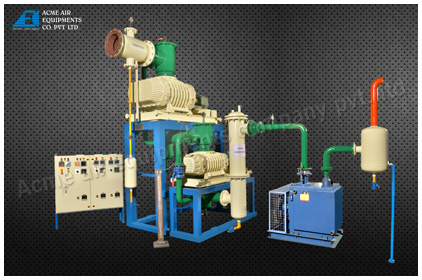Table of Contents
The performance of a vacuum system is never determined by its booster alone. Achieving peak output demands a coordinated orchestration of components – primary pumps, condensers and automated controls – each tailored to specific process requirements. The keyword here is integration. When these elements operate in isolation or without precision tuning, the vacuum booster system risks underperformance, energy inefficiency or even failure.
This article focuses on how to strategically optimize vacuum booster systems by integrating these components into a cohesive system architecture designed for maximum throughput, reliability and process consistency.
Integrating Primary Pumps with Vacuum Boosters: Balancing the System Core
At the core of every vacuum booster system lies a pressure-dependent relationship between the high booster and its primary pump. For peak output, this pairing must ensure that the booster receives a stable backing pressure within its operational envelope.
Optimization Strategies:
- Select a primary pump with sufficient volumetric flow to maintain constant backing pressure.
- Use pump types that match the vapor and particulate nature of the gas load.
- Install intermediate pressure sensors to dynamically manage pressure ratios and avoid overloads on the booster.
When primary stages are aligned in capacity and pressure staging, the system delivers higher vacuum levels in less time, without stressing mechanical tolerances.
The Role of Condensers in System Stability and Performance
In high-moisture or vapor-heavy processes, condensers are essential to safeguard the vacuum booster and the backing pump. Integrated upstream of the booster, they remove condensable loads, prevent fluid backflow and maintain dry compression environments.
Integration Guidelines:
- Condensers must be matched to vapor load and positioned for efficient vapor-liquid separation before gas enters the booster.
- Use water-cooled or air-cooled designs based on cooling availability and process conditions.
- Include automatic drain systems or liquid level monitoring to prevent condensate accumulation and booster damage.

By intercepting problematic vapors, condensers allow boosters to operate within safe thermal and mechanical boundaries, directly supporting system longevity and efficiency.
Intelligent Control Integration: Enabling Real-Time Optimization
A mechanically sound system cannot reach peak output without real-time control. Automated control systems ensure each component operates in harmony – preventing mismatch, monitoring anomalies and adjusting parameters dynamically.
Key Control System Functions:
- Sequential Start-Up Logic: Ensures booster activation only after primary pump establishes minimum vacuum.
- Differential Pressure Safeguards: Shuts down or bypasses mechanical vacuum booster if pressure thresholds are exceeded.
- Thermal Monitoring: Prevents overheating through sensor-triggered interlocks.
- Flow and Load Feedback: Allows real-time adaptation to varying process conditions.
The integration of these controls translates into reduced cycle times, minimized manual oversight and more predictable vacuum system behavior across operational shifts.
Synchronizing the System for Continuous Performance
Optimization isn’t a one-time configuration – it’s a synchronized operation of all system elements. Each integration point – from pump discharge to booster inlet, from condenser outlet to pressure controller – must be continuously evaluated to maintain performance.
Best Practices for Synchronization:
- Use digital twins or simulation tools during design phase to forecast interactions under load.
- Apply vacuum logic interlocks to prevent cross-stage failure propagation.
- Implement control loops that link system components for pressure-balanced throughput.
When all system parts communicate and react to each other via intelligent controls, the mechanical vacuum booster performs not just efficiently, but adaptively – delivering peak output regardless of process variability.
Conclusion
Optimizing vacuum booster systems means more than installing high-capacity equipment. True optimization comes from precise integration – balancing primary pumps, condensers and automated controls around the booster’s capabilities and the application’s demands. By coordinating these components, Acme Air Equipments, a leading manufacturer of Vacuum Booster achieves maximum throughput, improved vacuum depth, lower operational risk and better energy use.
This systems-based approach transforms a basic booster into a high-efficiency solution platform – ready to meet the ever-increasing performance expectations of modern vacuum processing.
FAQs About Vacuum Booster Systems
Why is integrating primary pumps essential in vacuum booster systems?
Primary pumps maintain the backing pressure required for vacuum boosters to operate efficiently and avoid overload conditions.
What role do condensers play in optimizing vacuum booster performance?
Condensers remove vapors before they reach the booster, preventing damage and maintaining dry, stable operating conditions.
Can vacuum booster systems be automated for better performance?
Yes, integrating control systems enables real-time monitoring, pressure regulation and sequential operations for optimized output.
What happens if pressure ratios are not balanced between the booster and primary pump?
Imbalanced pressure can cause booster inefficiency, overheating or mechanical stress, reducing system lifespan.
How do control systems enhance vacuum system reliability?
They ensure safe inter-stage operations, detect faults early and adapt the system dynamically to varying process loads.
About Author

CEO
Mr. Vishwesh Pardeshi is the CEO of Acme Air Equipments Company Pvt. Ltd., an industrial and engineering goods manufacturing company based in Ahmedabad, Gujarat (India). He has taken over the responsibility from founding Partners and Directors of the Company, and is now leading a talented group of professionals since 2020 by bringing in vast industrial and management expertise. By qualification, he holds a Bachelor Degree in Mechanical Engineering and also holds a MBA degree from reputed institutes. Under his leadership, the Company has successfully executed prestigious projects by delivering high quality and world class products from a state of the art manufacturing facility which combines CNC-enabled precision manufacturing and strong after sales support. In line with the Vision, Mission and Core Values of the Organization, Mr. Vishwesh Pardeshi continues to drive Quality, Reliability and Global Expansion at Acme Air Equipments Co. Pvt. Ltd.









